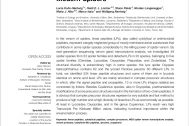Content
In the venom of spiders, linear peptides (LPs), also called cytolytical or antimicrobial peptides, represent a largely neglected group of mostly membrane active substances that contribute in some spider species considerably to the killing power of spider venom. By next-generation sequencing venom gland transcriptome analysis, we investigated 48 spider species from 23 spider families and detected LPs in 20 species, belonging to five spider families (Ctenidae, Lycosidae, Oxyopidae, Pisauridae, and Zodariidae). The structural diversity is extraordinary high in some species: the lynx spider Oxyopes heterophthalmus contains 62 and the lycosid Pardosa palustris 60 different LPs. In total, we identified 524 linear peptide structures and some of them are in lycosids identical on amino acid level. LPs are mainly encoded in complex precursor structures in which, after the signal peptide and propeptide, 13 or more LPs (Hogna radiata) are connected by linkers. Besides Cupiennius species, also in Oxyopidae, posttranslational modifications of some precursor structures result in the formation of two-chain peptides. It is obvious that complex precursor structures represent a very suitable and fast method to produce a high number and a high diversity of bioactive LPs as economically as possible. At least in Lycosidae, Oxyopidae, and in the genus Cupiennius, LPs reach very high Transcripts Per Kilobase Million values, indicating functional importance within the envenomation process.



